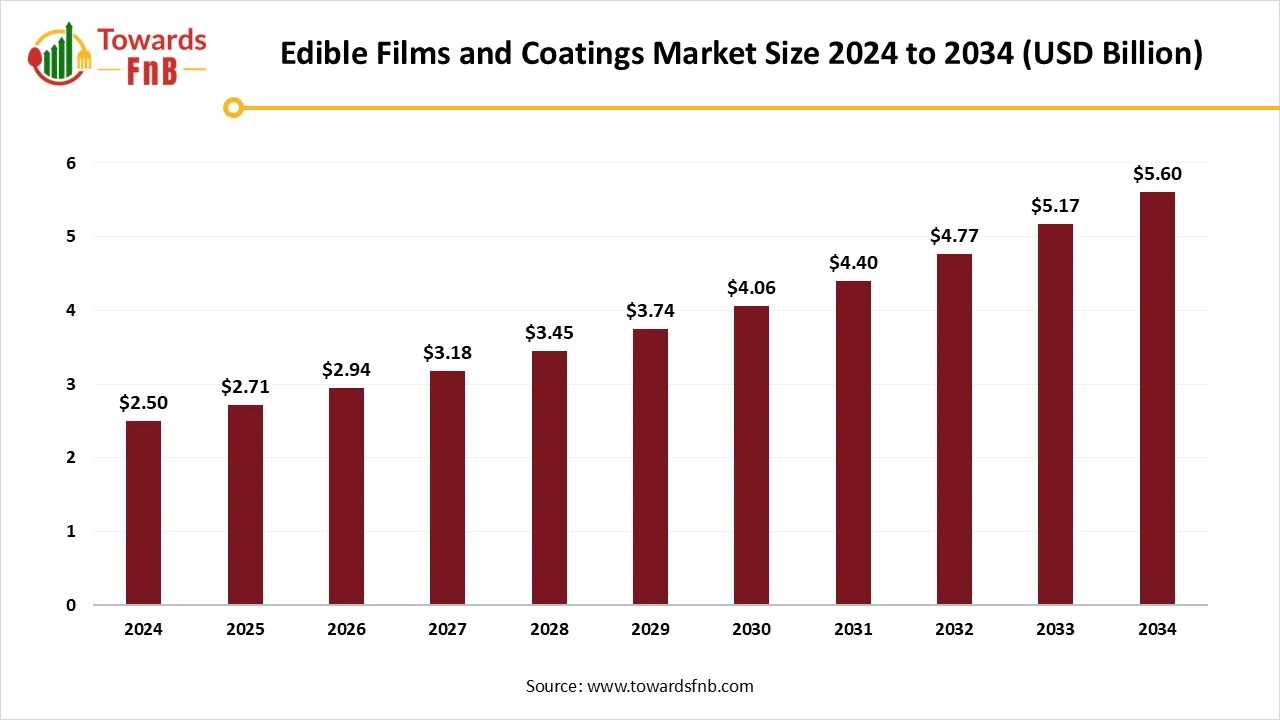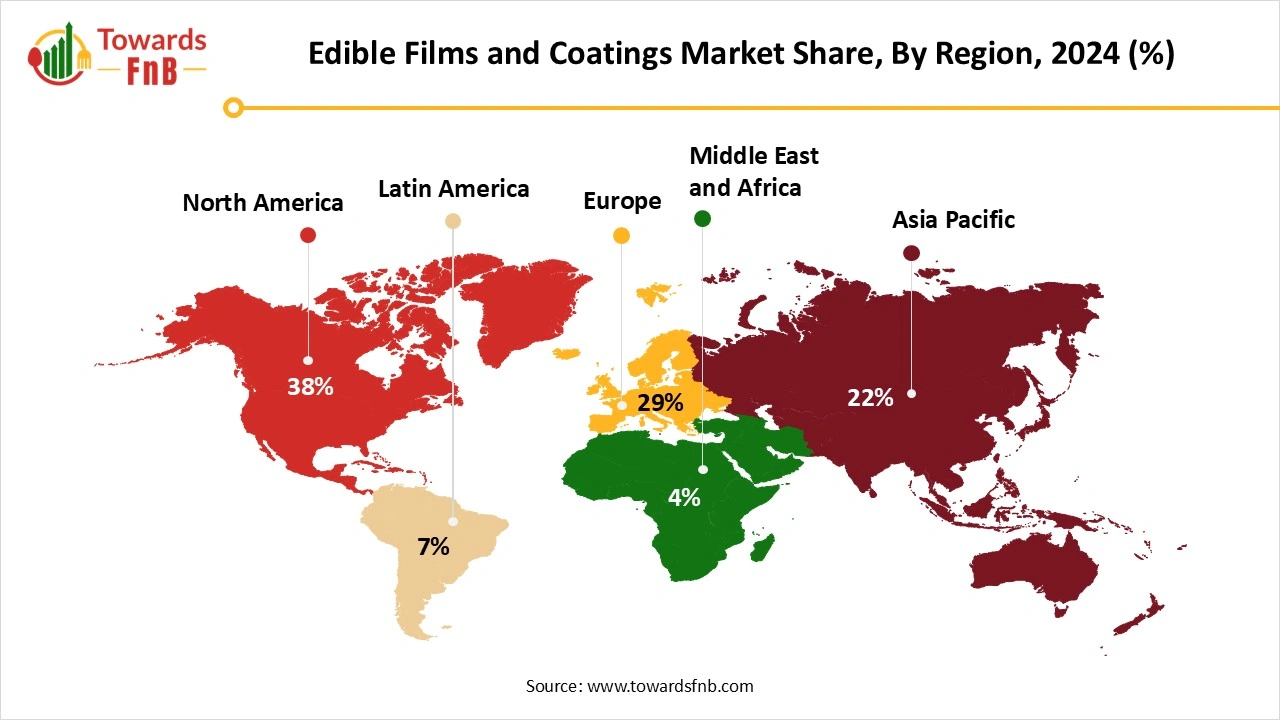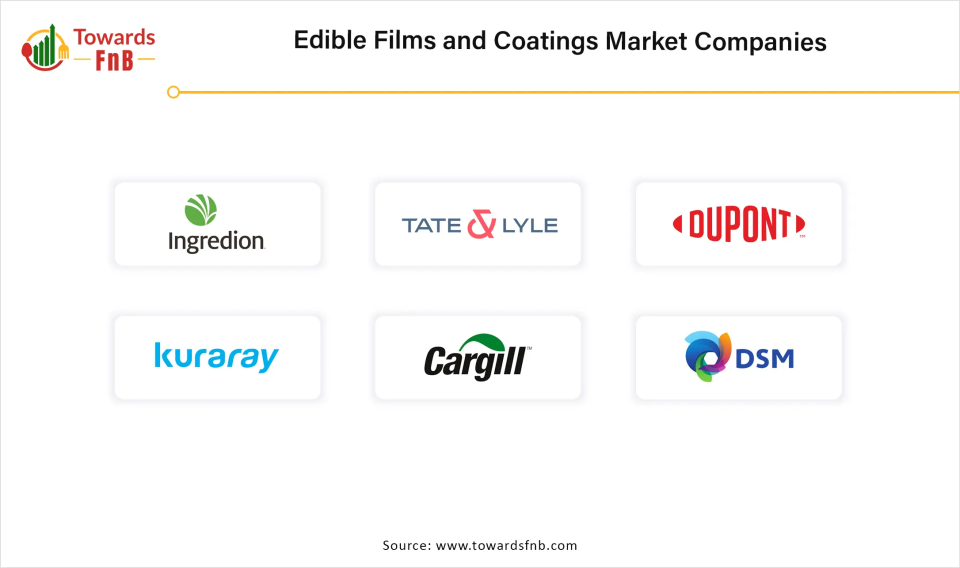October 2025
The global edible films and coatings market size was estimated at USD 2.50 billion in 2024 and is expected to rise from USD 2.71 billion in 2025 to nearly reaching USD 5.60 billion by 2034, growing at a CAGR of 8.4% during the forecast period from 2025 to 2034. Consumer demand for the sustainable eco-friendly packaging coupled with rising environmental concern and technological advantages driving the market.

| Study Coverage | Details |
| Growth Rate from 2025 to 2034 | CAGR of 8.4% |
| Market Size in 2025 | USD 2.71 Billion |
| Market Size in 2026 | USD 2.94 Billion |
| Market Size by 2034 | USD 5.60 Billion |
| Largest Market | North America |
| Base Year | 2024 |
| Forecast Period | 2025 to 2034 |
| Regions Covered | North America, Europe, Asia-Pacific, Latin America, and Middle East & Africa |
Edible films & coatings are thin layers of edible material applied on food products either by wrapping, dipping, or spraying to enhance shelf life, improve quality, and reduce moisture, gas, or solute migration. These coatings serve as a sustainable alternative to plastic packaging and can be consumed along with the food product. They are made from biopolymers such as proteins, polysaccharides, lipids, and composites. The need to minimize food spoilage and enhance shelf life is a strong driver for the adoption of edible films and coatings, especially in perishable categories such as fruits, vegetables, and bakery products
The emergence of cutting-edge and sophisticated technologies, like nanotechnology, has created fresh market opportunities. The use of intelligent technologies like time-temperature indicators and freshness sensors in edible films enables real-time monitoring of product quality. Tailored, multilayer coatings designed for food types also create new application opportunities. Leading firms in the edible films and coatings sector are creating innovative products like plant-derived edible coatings to attract broader consumer groups, boost sales, and grow profits. The market is focusing on expanding facilities to improve product quality and satisfy rising market demand.
The market for edible films and coatings encounters various obstacles, mainly concerning elevated production expenses. Producing these films requires specific materials and processes, potentially increasing expenses for manufacturers. Moreover, the scalability of manufacturing continues to be a challenge, hindering the broad acceptance of these products. As the need for sustainable packaging grows, it is crucial for businesses to strike a balance between cost-effectiveness and preserving the quality and performance of the coatings.
North America Dominated the Market in 2024.
Greater awareness of eco-friendly products, the involvement of international companies, easy access to edible films and coating products, and consumers' readiness to pay for them will propel the growth of this market segment. The market for convenience food is growing, and edible films are being utilized more frequently to coat snacks, fruits, and other ready-to-eat products to enhance their convenience, appearance, and preservation attributes. Ongoing expansion in the convenience food sector, along with a heightened emphasis on minimizing plastic waste, will allow North America to maintain its dominant role in the edible films and coatings market throughout the forecast period.
The American consumer market is progressively moving towards sustainable and eco-friendly products, fueling the growth of the U.S. Edible Films Coating Market Industry. The U.S. Edible Films Coating Market is witnessing notable trends fueled by rising consumer preference for natural and eco-friendly food packaging options. Consumers who prioritize health tend to favor products lacking synthetic additives, resulting in an increase in the use of edible coatings derived from natural sources. Innovation in food preservation technology is quickly changing the food industry in the U.S. As per the United States Department of Agriculture (USDA), progress in edible film technology enhances shelf-life and preserves freshness, reducing food waste.

Asia Pacific is Expected to Grow at Significant Rate in the Edible Films and Coatings Market During the Forecast Period.
Market is supported by the extensive agricultural foundation in the region and rising food exports along with a growing demand for sustainable food packaging. Post-harvest losses of fruits and vegetables are a significant issue for any nation that relies on agriculture for its economy. Nevertheless, this is a usual phenomenon in almost all developing nations. Fruits and vegetables are perishable items that need to be treated with great care to prevent deterioration. China, India, and Japan are putting money into biodegradable technologies for food packaging to minimize plastic usage. The local government is promoting adoption by implementing regulations related to food safety and zero-waste packaging. The increasing demand from the growing middle class for fresh and minimally processed food drives further market growth.
Japan's market for edible films and coatings is propelled by meticulously designed advancements in food-grade and eco-friendly trends. This nation is among the rare supporters of clean-label and functional packaging options; consequently, producers have been creating ultra-thin, eco-friendly, and heat-resistant edible coatings. To enhance food longevity, businesses utilize edible films made from seaweed, chitosan, and collagen. The rising demand for eco-friendly, innovative packaging trends enables brands to introduce antimicrobial edible coatings, flavor-boosting agents, and moisture-regulating agents. Advancements in high-barrier edible films continue to influence consumer choices in Japan.
Which Material Type Segment Dominated the Edible Films and Coatings Market in 2024?
Polysaccharide-Based segment dominated the edible films and coatings market in 2024. Polysaccharides offer great advantages for edible films and coatings because of their sustainability, adaptability, and capacity to include active compounds that improve food preservation. Combining them with other biopolymers can address issues such as moisture sensitivity, while enhancing their use in sustainable food packaging solutions. In recent times, as the emphasis on sustainable food packaging solutions has increased, polysaccharide-derived materials, which are plentiful and structurally varied, have been extensively researched for creating edible films and coatings.
Composite Materials Segment is Observed to Grow at the Fastest Rate During the Forecast Period.
This section is motivated by the necessity to enhance barrier characteristics, mechanical durability, and overall performance of edible films and coatings. Composite edible films and coatings have been widely employed to enhance the shelf life and quality of various food systems, including fresh produce, dairy, meat, and seafood.
Which Source Segment Held the Dominating Share of The Edible Films and Coatings Market in 2024?
Plant based segment held the dominating share of the edible films and coatings market in 2024. Lately, the emphasis on plant-derived materials and edible films has grown because of heightened awareness regarding sustainability and environmental concerns. These films demonstrated favorable properties, such as biocompatibility, flexibility, and resistance to water and oxygen. Polysaccharides like cellulose, starch, chitosan, and alginate have attracted interest because of their availability, affordability, biodegradability, and capacity to form films.
Microbial Fermentation-Based Segment is Seen to Grow at a Notable Rate During the Predicted Timeframe.
Microbial fermentation depends on the renewable feedstock and lowers the need of the synthetic preservative and packaging materials. They merge functionality, sustainability and consumer health benefits, keeping themselves as the innovation driving the demand for the edible films and coatings. Certain microbes create film with natural antimicrobial activity and extend the shelf life and prevent the spoilage of the food.
Why Fruits and Vegetables Segment Dominate the Edible Films And Coatings Market in 2024?
Fruits and vegetables segment dominated the market with the largest share in 2024. Consumption of natural and healthy meals has increased demand for fruits and vegetables, which in turn has increased demand for fresh produce in the market throughout the year. As the population increases, so do the demands on the food industry. Because it preserves texture, promotes mass transfer in product, reduces oxidative reactions on fruits and vegetables, and enhances gloss and shine, the edible coating is widely used on fruits and vegetables.
Nutritional Products and Bars Segment is Expected to Grow at the Fastest Rate in the Market During the Forecast Period.
Central to the growing segment for nutritional products and bars are the rising number of health-conscious consumers who favor high proteins, fibers, and various functional food items. Furthermore, the move towards plant-based and organic nutrition bar products has expanded the range of consumers. Consumers are looking for sustainable and convenient choices, leading to the rise of edible packaging in the food and drink sector which is fostering the edible films and coatings market.
Which Functionality Segment Held the Largest Share of the Edible Films And Coatings Market in 2024?
Moisture barrier segment held the largest share of the market in 2024. Edible films and coatings function as efficient moisture barriers, safeguarding food items from moisture fluctuations, which helps increase their shelf life. These moisture barriers are becoming increasingly popular within the food industry for improving product preservation and lengthening shelf life. These obstacles, frequently employing lipids or hydrophobic substances in the coating, assist in regulating moisture movement, minimizing weight loss, and stopping spoilage in food items. They can also stop moisture from the environment from getting into the food, which may cause spoilage or alterations in texture.
Antimicrobial Coating Segment is Observed to Grow at the Fastest CAGR During the Forecast Period.
The rise in awareness regarding health and hygiene has escalated because of the covid-19 pandemic, thus boosting knowledge about antimicrobial food. The antimicrobial layer offers over 90% longevity for food products and is among the safest methods to preserve food items. These coatings, frequently containing natural antimicrobial substances, provide a hopeful approach for maintaining food quality and lessening dependence on artificial preservatives and packaging.
How Did Dipping Segment Dominate the Edible Films and Coatings Market in 2024?
Dipping segment dominated the edible films and coatings market in 2024. Dipping is an easy procedure that doesn't need advanced tools or specific expertise, which makes it a favored option for both laboratory studies and minor commercial uses. Submerging the food product in the solution facilitates uniform spread of the coating material, guaranteeing that every surface is coated, even those with irregular contours. Although effective, dipping may cause dilution of the coating solution, residual coating material, and increase the risk of microbial growth in the dipping tank.
Spraying Segment is Seen to Expand at a Notable Rate During the Predicted Timeframe.
Spraying provides a uniform, consistent layer of coating over the entire food surface, guaranteeing even protection and intended characteristics. In contrast to dipping, which can lead to the disposal of surplus coating solution, spraying reduces material waste, rendering it a more economical and eco-friendly choice. This method has benefits compared to other approaches such as dipping, since it can be utilized for various food shapes and sizes while providing improved management of coating thickness and distribution.
Which Distribution Channel Held the Biggest Share of The Edible Films and Coatings Market in 2024?
B2B (food manufacturers) segment held the biggest share of the edible films and coatings market in 2024. B2B channel marketing acts as an essential communication link that connects businesses with their partners. These alliances are founded on cooperation, confidence, and shared advantage. Producers can employ tailored marketing approaches to target particular customer groups. By removing middlemen, producers could potentially secure greater profit margins.
B2C (retail & online channels) Segment is Expected to Grow at the Fastest CAGR in the Market During the Forecast Period.
The edible films and coatings market is seeing a growing significance in retail and online channels, as online platforms transform distribution and customer interaction. This change is motivated by the increasing need for eco-friendly packaging, longer shelf life, and the ease of online shopping. Certain businesses are utilizing their websites or applications to sell straight to customers, providing tailored solutions and fostering direct connections.
Why did Primary Packaging Segment Dominate the Edible Films And Coatings Market with the Largest Share in 2024?
Primary packaging segment dominated the market with the largest share in 2024. Primary packaging fulfills various roles based on the product, shipping conditions, and storage needs. It safeguards the products during storage, even for long durations, and enhances their visual appeal and marketability. Edible primary packaging signifies a move towards more sustainable and creative food packaging options, in line with increasing consumer interest in eco-friendly items.
Standalone Film Wrap Segment is Expected to Grow at the Fastest CAGR in the Market During the Projection Period.
Rising customer demand for eco-friendly packaging is encouraging industries to adopt standalone film wrap to enhance brand image. Developments in biopolymer technology are making these films more competitive in performance and quality. A significant trend in the standalone film wrap is the fostered shift toward circular packaging solutions, boosted by mandated corporate ESG mandates and government-led plastic reduction frameworks.
Akorn Technology
ACE (The Alliance for Beverage Cartons and the Environment) and EXTR:ACT
Thinkink Packaging

By Material Type
By Source
By End Use Application
By Functionality
By Technology / Application Method
By Distribution Channel
By Packaging Type
By Region
The global hemp protein market size is forecasted to expand from USD 173.21 million in 2025 to USD 269.85 million by 2034, growing at a CAGR of 5.05% ...
The global ketogenic diet food market size is projected to expand from USD 12.85 billion in 2025 to USD 20.13 billion by 2034, growing at a CAGR ...
The global industrial hemp market size is projected to expand from USD 13.54 billion in 2025 to USD 84.09 billion by 2034, growing at a CAGR of 22.5% ...
The global ready-to-eat food packaging market size is set for steady growth increasing from USD 95.17 billion in 2025 to USD 164.92 billion by 2034, w...
October 2025
October 2025
October 2025
October 2025